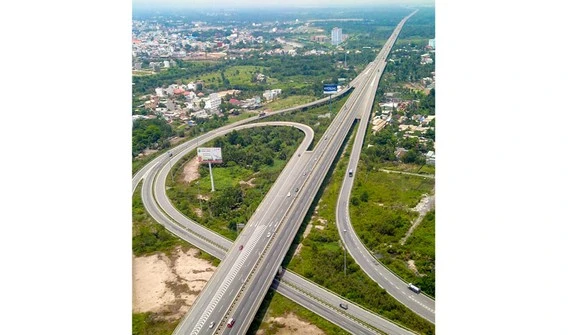
High risk of generating bad debt
According to the Ministry of Transport, this proposal by the State Bank will help to avoid disrupt the financial plans of projects, avoid BOT investment from being converted into bad debt, or affect the plans of the investor, with TCT 36 in particular, and the project enterprise in general. Eventually it will affect the policy of calling for investment in developing transport infrastructure in the form of Public-Private Partnership (PPP). If banks are not allowed to restructure their debt and maintain the debt group, the VND 995 bn credit disbursed to TCT 36 will become bad debt, and many banks that have other BOT loans will also fall into a similar situation.
In a report submitted at the eighth session of the fourteenth National Assembly, the State Bank stated that many BOT and BT Transport Projects that have been completed were operating with negative revenue and therefore outstanding loans of about VND 53,000 bn are in danger of converting to bad debts.
This is probably a mandatory step by the banking authorities, because for many years the State Bank had been continuously warning of the situation that banks tend to increase investment capital to finance BOT and BT transport projects. Specifically, in July 2015, the State Bank issued Directive No. 05 for strengthening risk control in credit activities of BOT and BT transport projects. Previously, the State Bank had also sent a document to the Government specifying the problems of credit institutions when lending for transport infrastructure investment, but the lending speed for BOT projects is still showing no signs of slowing down.
By 2016, the State Bank solutions as per Directive No. 04 for managing monetary policies and banking activities continued to remind credit institutions to strengthen risk control for big customers, and for credit in BOT and BT transport projects. After that, BOT and BT were included in the risk lending sector of banks. At the seventh session of the fourteenth National Assembly, the State Bank continued to reiterate the provisions of credit to BOT and BT transport projects with long-term risks, due to projects with large investments, long-term loan periods, and limited financial capacity of investors. The risk of converting debts to bad debts was extremely high.
Audit necessary to ensure accuracy
According to published data, until 31 March 2019, 24 credit institutions had implemented credit for 105 BOT and BT transport projects, of which 93 projects have been completed and put in operation with a total credit of VND 175,296 billion, and total outstanding loan of VND 103,573 billion. By September 2019, credit for BOT and BT projects increased by 1.85% compared to the end of 2018, accounting for 1.4% of total outstanding loans. With about half of the outstanding loans exposed to risk of restructuring and generating bad debts, the State Bank is intending to "save" these BOT projects. These potential bad debts could be "suspended" to await payment from revenue sources.
Commenting on this, Dr. Nguyen Minh Phong, an economist, said that BOT projects showing a decline in revenue were only one-way reports from investors and the State Bank without auditing. Because other reports related to BOT revenue showed profits. Assuming that this is true, the State Bank proposal to maintain the debt group will also be grounded. Because if the debt structure by keeping the debt group and without directly affecting other issues can be done, the domestic banking system is currently classifying debts according to Vietnamese standards and not by Basel II or international standards.
Dr. Nguyen Minh Phong emphasized, “BOT revenue depends on many factors, including state management, the issue of right and wrong in the implementation process, as well as the impact of public opinion leading to difficulties in collecting fees. However, despite these factors, and before confirming the situation, it is necessary to have an audit to ensure accuracy, instead of relying only on reports of the projects and avoid being led by investors”.
Imperative to complete PPP Law urgently
In order to resolve investment problems in the Public-Private Partnership law, experts believe that raising the equity ratio of investors is not enough to reduce risks for banks, and there must be other solutions for PPP projects to no longer be a burden for banks. Because regulations on PPP in Vietnam are evaluated by investors and are not stable, PPP project contracts usually last 20-30 years, so investors as well as lenders often require a sustainable law to govern the contract.
Lack of capital for investors leads to a BOT investment going into wrong hands, besides having a negative impact in the construction process, which then raises project costs. These create high risks for all banks.
-Dr. Tran Du Lich, member of National Financial and Monetary Policy Advisory Council.
Therefore, in order to develop PPP well, it is necessary to clear many issues, such as obligations of the State, obligations of private investors in terms of capital, compensation policies for investors to ensure profitability, and responsibility of authorities when committing to the project. From 2010 till now, many experts have proposed building a separate law on PPP investment, instead of Decrees, which are not sufficient to ensure the legal framework to operate the PPP model, and which are not attractive enough for investors, especially foreign investors.
Even though the PPP Law serves as the essence and base to resolve many of the above issues, until now, only the draft PPP Law has been completed. It is therefore imperative that the PPP Law be completed urgently so that BOT and BT projects take off and run smoothly, and the banking sector is able to reduce BOT loans, as well as reduce potential risks of debts when granting credit for BOT projects.




















